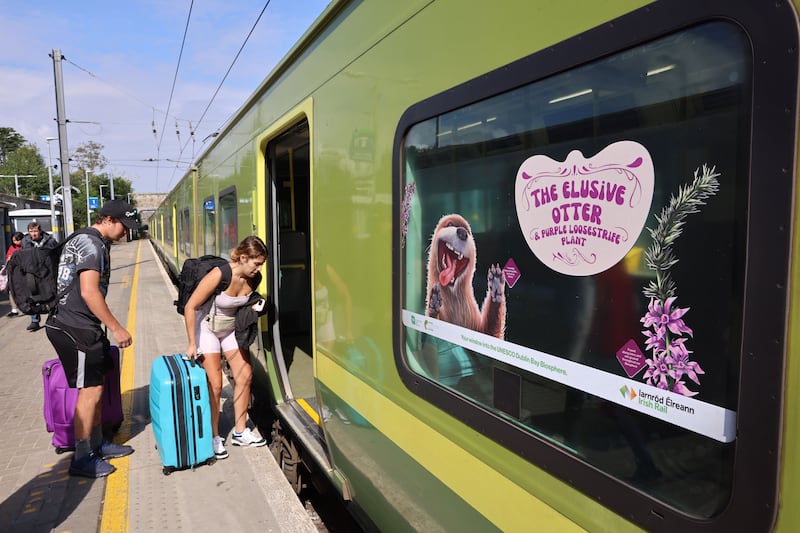Iarnród Éireann has defended an advertising campaign on its Dart services promoting the biodiversity of the Dublin Bay area after passengers complained that their view of the coast has been obstructed.
In January, Iarnród Éireann, in conjunction with the Dublin Bay Unesco Biosphere partnership, launched a campaign featuring window illustrations of animals to be found in Dublin Bay that were placed within a number of Dart carriages.
The series features 12 different animal illustrations, featuring squirrels, goats, porpoises, seals and other animals found in the bay, has been criticised recently by Dart users for obstructing their view of the bay which it serves to promote.
“While they are lovely, they take over the whole window,” says Karen Canning from Dalkey, south Dublin. “We just happened to be on the Dart on Wednesday bringing the grandchildren to Howth and noticed the stickers on the window.
“We couldn’t see out the window. With lovely coastal views it’s a pity, particularly the beautiful bay and boats.”
The fact that these poorly thought-out objects are there ostensibly to promote the beauty of ‘Dublin Bay’s Biosphere’ but in fact impede anyone from enjoying that same biosphere in peace seems to sum up the witless nature of modern life too perfectly
— Simon O'Neill, from Bray
Ms Canning added that her grandson, aged five, enjoyed the sticker of a curlew on the window near their seats but that he was disappointed he couldn’t look out over the bay. “I like the stickers,” she said. “I don’t have a problem, it’s good for children to be aware. I’ve never seen a curlew, I just don’t like how it’s over the whole window.”

In a letter to The Irish Times, Bruce Misstear, from Bray, Co Wicklow, noted that “without any apparent irony, there is a banner below each set of pictures saying: ‘Your window into the Dublin Bay Biosphere’.”
In another letter, Simon O’Neill, also from Bray, said that “the view from the Dart is a natural, free resource and taking time out to look upon the landscape is one of the great pleasures of commuting in and out of the city.
‘Poorly thought-out’
“The fact that these poorly thought-out objects are there ostensibly to promote the beauty of ‘Dublin Bay’s Biosphere’ but in fact impede anyone from enjoying that same biosphere in peace seems to sum up the witless nature of modern life too perfectly.”
Barry Kenny, head of corporate communications for Iarnród Éireann, said that the rail company has received both positive and negative feedback from Dart users about the campaign. “We’ve had positive, feedback particularly from people travelling with kids,” he said.
“The nature of the designs very much was to be engaging to kids in particular, and we have had some criticism, not a huge volume, there’s a general enjoyment of them by the family groups that we’ve heard from.”
Mr Kenny said that the illustrations, which can be viewed from both inside and outside of trains, were placed on 32 of 144 carriages in the Dart fleet.

In those carriages, they appear on 50 per cent of windows, alternating in a “zigzag order, meaning every second window has one, and there aren’t any areas where you’ll have two directly opposite each other, giving choice to customers who prefer windows with illustrations or without, subject to capacity of course.”
Ms Canning added that due to accessibility issues, she did not feel that the issue of choice of seats was a “fair comment”.
“If you’re on a full Dart you get a seat wherever you get a seat,” she added. “We had a little one aged 20 months in a buggy, there’s a limit to where you can sit in a buggy without blocking anyone’s seat.”
Upon the launch of the campaign in January, Jim Meade, chief executive of Iarnród Éireann, said the project’s aim was to “bring the biodiversity of the biosphere to life for our customers with these fun illustrations.”
‘Pique interest’
“Kids and adults alike will love them,” he added, “and we hope it encourages our customers to explore the biodiversity on their doorstep, and travel sustainably while doing so.”
Dan Eaton, biosphere co-ordinator for the Dublin Bay Biosphere Partnership, said that the project “will bring our wonderful wildlife a little closer to Dart passengers and we hope these caricatures will pique people’s interest to discover more about our internationally important wildlife and the biosphere they call home.”
Mr Kenny said the advertising campaign was to last for 12 months, and that the stickers will be removed in January 2024. “We will be continuing our partnership with the Dublin Bay biosphere but it will be something different,” he said.





